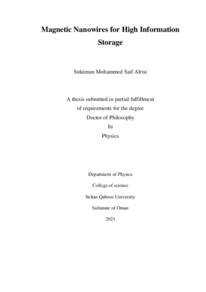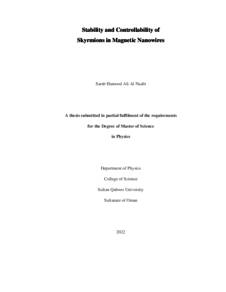Document
Magnetic nanowires for high information storage.
Other titles
استخدام سلك نانومغناطيسي في تخزين المعلومات بسعة عالية
Publisher
Sultan Qaboos University.
Gregorian
2021
Language
English
English abstract
In the last few decades, a race has been accelerated to achieve high-capacity data
storage to satisfy the growing demand for storage memory. Domain wall (DW)
memory devices can be an alternative scheme to achieve high capacity storage. In DW
memory, the manipulation of magnetic domain walls (DW)s in ferromagnetic
nanowires by a polarized current and a magnetic field has become the booming
research activity in theoretical and experimental exploration. It attracts much attention
recently due to its applications in logic and magnetic memory devices. This thesis
explores a stepped magnetic microstructure with perpendicular magnetic anisotropy
for multi-bit per cell memory. In the proposed wire, data is stored in a magnetic domain
wall that can be moved along the wire using a magnetic field or current. The wire
exhibits two magnetic domains, which are separated by a DW. Thus, for this nanowire
to exhibit high-density data storage, it is essential to stabilize the DW in many sites
along the wire using a current or magnetic field.
To study the structure and dynamics of magnetic domains in a material, a magneto optic Kerr effect (MOKE) microscopy instrument is required. It is a powerful imaging
technique that can be employed to study the magnetization reversal of thin films
and nanoscale structures. In this work, we built a MOKE microscope to observe the
structures of magnetic domains and plot the hysteresis loop of their magnetization
reversal. It is possible to image the magnetization evolution in a micron-sized magnetic
domain on a sub-ms time scale with a lateral spatial resolution down to 300 nm for thin
films and nanowires of magnetic multilayers (MLs).
After that, the study was directed to investigate thin films multilayers to select suitable
material for domain wall devices. Hence, the magnetic domain structures and magnetic
properties of multilayers (Co/Ni), (Co/Pt), and (Co/Pd) thin films multilayers have
been investigated. The domain size and nucleation field of (Co/Ni) multilayers were
found to be reduced as the number of bilayers increases. On the other hand, (Co/Pd)×10
multilayer has a much larger domain size, faster magnetization switching, and a higher
nucleation field than Co/Ni and Co/Pt. The magnetization reversal for Co/Pt
MLs occurs by enlarging the domain in all directions as dendritic domain wall
vi
propagation. The evolution started in many sites, and then the domains grow up with
no new nucleated sites when a fixed or increased magnetic field was applied for Co/Ni
and Co/Pt. The magnetic domain size for (Co/Ni)×12 and (Co/Pt)×12 were less than 200
nm. Hence they were selected for the lithography process to fabricate the nanowire
devices.
A dynamic micromagnetic simulation is carried out using the Object-Oriented
MicroMagnetic Framework (OOMMF) software to study the domain wall dynamics
in the stepped magnetic wires (Co/Ni)×12. A stepped nanowire with 200×40 nm multi bit per cell scheme. It was found that DW pinning strength depends on the length (d)
and width (λ) of the step. The DW speed was found to increase when nanowire width
(𝑊) decreases and thickness ( tz ) increases. A higher depinning current (Jde) could be
achieved with larger thickness and lower widths of the nanowire. As step length (d)
increases, the depinning current increases. Also, DW pinning strength at stepped
positions could be controlled by the materials properties such as magnetic anisotropy
Ku and saturation magnetization Ms. It was shown that the depinning current of DW
from the stepped position increase with increasing Ku and decreasing Ms, offering thus
more flexibility in adjusting the writing current for memory applications.
Experimentally, micro-devices of (Co/Pt)×12 and (Co/Ni)×12 stepped wires (in 50 µm
length and 1 µm width) were fabricated by electron-beam and laser lithography. Along
the wire, six nano-constrictions with off-set in x and y directions, represented by and
d, were created. We found from MOKE microscopy imagining; the (DW) could be
manipulated and pinned precisely through six positions using STT and magnetic field.
It was possible to stabilize the DW at each step by a magnetic field in the stepped wire
with d = 600 nm and = 0 nm. The DW could be moved to the first step by applied
65 mT for (Co/Pt)×12 and 35 mT for (Co/Ni)×12. Moreover, a current around 4 mA with
an assisted 6 mT magnetic field was required to stabilize the DW along (Co/Pt)×12
device. Finally, it was found that the DW will remain stable for more than five years
in the (Co/Pt)×12 device. Thus, the proposed staggering configuration could be
employed to fine-tune DW devices properties for memory applications with multiple bit-per-cell memory
Member of
Resource URL
Arabic abstract
تتزايد كمية المعلومات المختلفة والتي يتم تداولها إلكترونيا،و تنتشر بشكل كبير في كل المجالات وتحتاج ألجهزة تخزين تستطيع استيعابها ومعالجتها، وبالتالي الحاجة ملحة وضرورية لذاكرة جديدة ، تستطيع استيعاب الثورة المعلوماتية الحديثة المرتبطة بالذكاء الاصطناعي وانترنت كل الاشياء ، وتلبي حاجة الطلب المستمر لذاكرة بسعة مضاعفة الاف المرات عن الذاكرة الحالية ومتناهية في الصغر وتعمل بسرعة فائقة باستهالك طاقة كهربائية منخفظة. وتتجاوز السلبيات والعوائق الموجودة في أجهزة التخزين الحالية ، فال ريب أن كثيرمن المراكز البحثية في كل العالم والشركات المنتجه ألجهزة التخزين تتسابق وتتنافس للوصول لذاكرة جديدة. ومن التطبيقات الواعدة لذلك ، الجدار المغناطيسي الفاصل بين الاتجاهين المتعاكسين للمغنطة المغناطيسية wall domain، حيث يعتبر هذ البحث مواكبا لسير الابحاث العلمية الحديثة في هذا المجال على مستوى العالم ، فهذا المشروع قائم على استخدام الاتجاه العمودي للمغنطة المغناطيسية داخل المادة، فعندما يمتلك السلك المغناطيسي اتجاهين متعاكسين للمغنطة المغناطيسية ، ينشأ بينهما جدار فاصل wall Domain يفصل الاتجاهين وعرض هذا الجدار أقل من 10 نانومتر ، وبالتالي يمكن استخدام هذا الجدار في تخزين المعلومات بتحريكه على طول السلك بواسطة تيار كهربائي أقل من 1 ميكرو أمبير، حيث طرحنا تصميم مستجد ومبتكر للسلك المغناطيسي ليستخدم في تخزين المعلومات. ويعتبر تحريك هذا الجدار في سلك مغناطيسي باستخدام تيار كهربائي من المواضيع المثارة مؤخرا في ساحة البحث العلمي في هذا المجال. والسبب في ذلك إمكانية استخدام هذا الجدار في أجهزة الذاكرة سواء لكتابة أو قراءة المعلومات. في هذه الدراسة تم إستقصاء سلك مدرج يحتوي على عدة درجات، وتم اختيار المواد المغناطيسية المستخدمة في التصنيع التي يكون اتجاه مغناطيسيتها عموديا على سطح السلك. الهدف من هذا السلك هو زيادة سعة التخزين للخلية الواحدة)السلك النانومتري( ألاكثر من بيت cell/bit-multi. ويتم تخزين المعلومات بتحريك الجدار الفاصل من درجة إلى أخرى باستخدام مجال مغناطيسي أو تيار بحيث يكون موقع الجدار في كل موقع يمكن قرائته كبيت bit ، مما سيزيد من سعة التخزين. يعتبر هذا الجدار نطاق فاصل بين منطقتين منغاطيسيتين متعاكستين في الاتجاه المغناطيسي، والذي يعتبر كموضوع مثار مؤخرا لاهميته في تصنيع أجهزة الذاكرة. ولدراسة المواد المغناطيسية سواء كانت أسالك نانومترية متناهية في الصغر أو كعينات مسطحة رقيقة متعددة الطبقات films thin سنحتاج جهاز خاص لدراسة المواد المغناطيسية ، وأفضلها فيما يسمى المجهر الضوئي المغناطيسي القائم على قاعدة تأثير كير effect Kerr. يعطي هذ الجهاز امكانية دراسة تركيب المناطق المغناطيسية واتجاهها وحجمها ، وأيضا يقدم مالحظة مباشرة لحركة النطاق المغناطيسي مع تغير المجال المغناطيسي أو التيار الكهربائي. ولذلك تم في هذه الدراسة بناء وتصنيع هذا الجهاز محليا بدقة قياس تصل إلى 200 نانوميتر لمشاهدة نطاقات المغنطة المغناطيسية. بعد ذلك تم دراسة رقائق مسطحة لمواد مغناطيستها عموديا على سطح المادة ، حتى يتم اختيار المناسب منها لتصنيح الاسلاك النانومترية بحسب الخصائص المغناطيسية وحجم المنطقة المغناطيسية ، وهذي المواد هي Ni/Co و Pt/Co و Pd/Co. حيث وجدنا من الدراسة أن حجم الانطاقات المغناطيسية يقل كل ما زاد عدد الطبقات في المادة. وحركة المغناطيسية في المادة تبدأ بظهور مناطق صغير جدا مع المجال المغناطيسي ثم تزيد وتتحرك في كل الاتجاهات حتى تغطي سطح المادة. وأظهرت الدراسة أن Pd/Co يمتلك أكبر المناطق المغناطيسية حجما ، بينما Ni/Co و Pt/Co ب12 طبقة تمتلك أصغرها ، ولذلك تم اختيارها لتصنيع الاسلاك المدرجة النانومترية. ولكي يتم فهم الحركة المغزلية ونوعها للجدار النطاقي في المنطقة المدرجة للسك ، استخدمنا برنامج المحاكاة طولة سلك تصميم تم حيث ، The Object Oriented Micro-Magnetic Framework (OOMMF) nm 200 وعرضه nm 40 ، وفي منتصفه مدرجة واحدة ، لكي تحجز الجدار النطاقي، أظهرت الدراسة كلما زاد طول الدرجة زادة قوة ثبات الجدار في موقعها. ويقل كلما قل عرض الدرجة. ووجدنا أن سرعة حركة الجدار تزيد مع زيادة سمك السلك ونقصان عرضه. ولكي يتحرر الجدار من منطقة الدرجة ،بحسب النتائج من المحاكاة يجب تزويد السلك بتيار يزيد كلما قل عرض السلك وزاد سمكه وزاد طول الدرجة. ولكون المواد المغناطيسية viii تختلف قي خصائصها الا أن أهم خاصيتن هما Ms saturation magnetization و anisotropy magnetic Ku واللتان يجب فهم تأثيرهما على حركة وحجز الجدار النطاقي في السلك. ووجدنا أن كلما زاد Ku وقل Ms للمادة ، زادت قيمة التيار الالزمة لتحرير الجدار النطاقي من منطقة الدرجة. وفي الحقيقة اتضح لنا أنه يمكن التحكم بسرعة وحركة الجدار النطاقي في السلك النانومتري والذي يمكنه أن يكون في أجهزة الذاكرة مستقبال بتخزين اكثر من بيت bit في الخلية الواحدة. وعمليا تم تصنيع أسالك مغناطيسية ، بكل سلك 6 مدرجات ، من المواد 12×(Ni/Co (و 12×(Pt/Co (، وكل سلك طوله µm 50 وعرضه µm 1 ، وتم التصنيع باستخدام تقنية lithography laser and beam-electron . وباستخدام المجهر المغناطيسي تم مشاهدة حركة الجدار النطاقي من موقع مدرج إلى آخر. حيث وجدنا أفضل مدرجة لحجز الجدار النطاقي في السلك الذي درجاته طولها nm 600 ، وعرضها صفر . حيث وجدنا لكي نضع الجدار في المدرجة الاولة نحتاج مجال مغناطيسي mT 65 بالنسبة ل 12×(Pt/Co (و نحتاج mT 50 بالنسبة ل 12×(Ni/Co(، ومن ثم تم تحريك الجدار من موقع إلى آخر متأثر بقوة الحجز لكل درجة. واستخدمنا المجال المغناطيسي لتحريك الجدار في 12×(Pt/Co (والتيار الكهربائي بالنسبة ل 12×(Ni/Co(. والاهم في ذلك وجدنا أنه يمكن حجز الجدار في الموقع الواحد لأكثر من 5 سنوات مما يعطي أجهزة الذاكرة ثبات عالي مع سعة كبيرة.
Category
Theses and Dissertations


